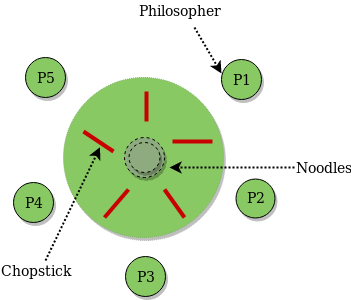先决条件– 流程同步, 信号量, 使用监视器的餐饮哲学家解决方案
餐饮哲学家的问题–用餐哲学家问题指出, K位哲学家坐在圆桌旁, 每对哲学家之间有一根筷子。每个哲学家之间只有一根筷子。如果一个哲学家可以拿起他旁边的两根筷子, 他可能会吃东西。一根筷子可以由其相邻的任何一个跟随者捡起, 但不能同时被两个捡起。

餐饮哲学家的信号量解决方案–
每个哲学家都由以下伪代码表示:
process P[i]
while true do
{ THINK;
PICKUP(CHOPSTICK[i], CHOPSTICK[i+1 mod 5]);
EAT;
PUTDOWN(CHOPSTICK[i], CHOPSTICK[i+1 mod 5])
}哲学家有三种状态:思维, 饥饿和进食。这里有两个信号量:互斥体和哲学家的信号量数组。使用互斥量使得没有两个哲学家可以同时访问取件或取件。该数组用于控制每个哲学家的行为。但是, 由于编程错误, 信号量可能导致死锁。
代码–
#include <pthread.h>
#include <semaphore.h>
#include <stdio.h>
#define N 5
#define THINKING 2
#define HUNGRY 1
#define EATING 0
#define LEFT (phnum + 4) % N
#define RIGHT (phnum + 1) % N
int state[N];
int phil[N] = { 0, 1, 2, 3, 4 };
sem_t mutex;
sem_t S[N];
void test( int phnum)
{
if (state[phnum] == HUNGRY
&& state[LEFT] != EATING
&& state[RIGHT] != EATING) {
//state that eating
state[phnum] = EATING;
sleep(2);
printf ( "Philosopher %d takes fork %d and %d\n" , phnum + 1, LEFT + 1, phnum + 1);
printf ( "Philosopher %d is Eating\n" , phnum + 1);
//sem_post(&S[phnum]) has no effect
//during takefork
//used to wake up hungry philosophers
//during putfork
sem_post(&S[phnum]);
}
}
//take up chopsticks
void take_fork( int phnum)
{
sem_wait(&mutex);
//state that hungry
state[phnum] = HUNGRY;
printf ( "Philosopher %d is Hungry\n" , phnum + 1);
//eat if neighbours are not eating
test(phnum);
sem_post(&mutex);
//if unable to eat wait to be signalled
sem_wait(&S[phnum]);
sleep(1);
}
//put down chopsticks
void put_fork( int phnum)
{
sem_wait(&mutex);
//state that thinking
state[phnum] = THINKING;
printf ( "Philosopher %d putting fork %d and %d down\n" , phnum + 1, LEFT + 1, phnum + 1);
printf ( "Philosopher %d is thinking\n" , phnum + 1);
test(LEFT);
test(RIGHT);
sem_post(&mutex);
}
void * philospher( void * num)
{
while (1) {
int * i = num;
sleep(1);
take_fork(*i);
sleep(0);
put_fork(*i);
}
}
int main()
{
int i;
pthread_t thread_id[N];
//initialize the semaphores
sem_init(&mutex, 0, 1);
for (i = 0; i <N; i++)
sem_init(&S[i], 0, 0);
for (i = 0; i <N; i++) {
//create philosopher processes
pthread_create(&thread_id[i], NULL, philospher, &phil[i]);
printf ( "Philosopher %d is thinking\n" , i + 1);
}
for (i = 0; i <N; i++)
pthread_join(thread_id[i], NULL);
}注意 -下面的程序只能使用带有信号灯和pthread库的C编译器进行编译。
参考–
餐饮哲学家的解决方案– cs.gordon.edu
餐饮哲学家的解决方案– cs.indiana.edu

![从字法上最小长度N的排列,使得对于正好为K个索引,a[i] a[i]+1](https://www.lsbin.com/wp-content/themes/begin%20lts/img/loading.png)